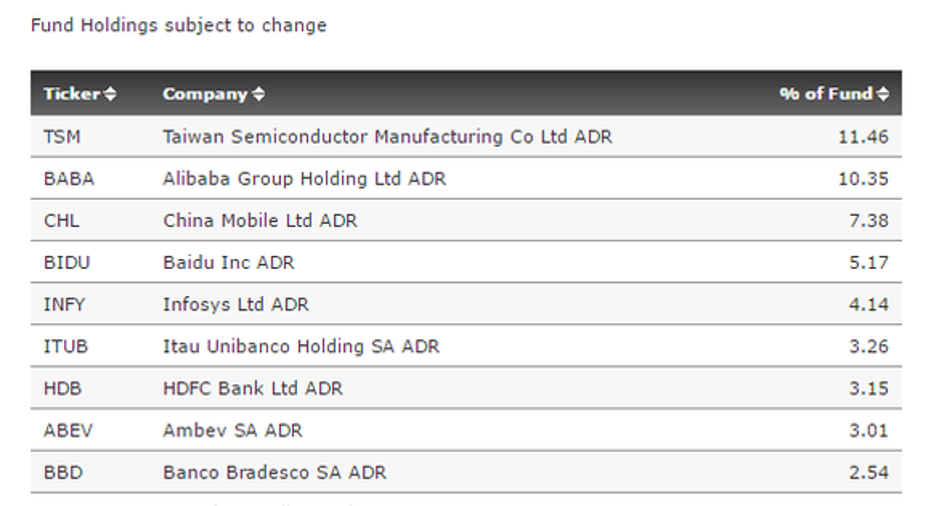The Best Emerging Market Stock ETFs

Image source: Getty Images.
In theory, emerging-market stocks should outperform their developed-market peers over long time periods. Indeed, since the year 2001, the MSCI Emerging Markets Index has provided an annualized return of nearly 8.5%, versus a comparable 3.6% annualized return for that ever-handy proxy for developed markets, theS&P 500 Index.
Yet emerging markets are also more susceptible than larger markets to the cyclical extremes of the global economy. Over the last trailing five years, as of the end of May 2016, the MSCI index has averaged a return of -4.5%. During the same time period, the S&P 500 has achieved appreciation of nearly 12% per year.
With both developed economies and the vanguard of the emerging markets, the BRIC countries (Brazil, Russia, India, and China), currently fighting slower gross-domestic-product growth, it seems unlikely that younger equity markets will find a catalyst to outperform in the very near future.
For the brave investors who are ready to invest now to reap a payoff perhaps years into the future, let's review three of the best emerging market exchange-traded funds (ETFs), each of which offers a unique approach to capitalizing on global growth.
A blended strategy in "investable markets"
The iShares Core MSCI Emerging Markets ETFis one of the larger emerging-markets ETFs available for investment, boasting nearly $12.7 billion of assets under management.The fund seeks to replicate performance of the MSCI Emerging Markets Investable Markets Index, which contains a broad cross section of small-, medium-, and large-capitalization stocks, spread across 23 emerging-market countries.
The Investable Markets Index is designed to capitalize on the evolution of globalized mid- and large-capitalization stocks that have benefited fromdecades of growth in the most-vibrant young economies. And it doesn't leave out the smaller-capitalization stocks that are closely associated with emerging markets in the minds of many investors.
As scores of prominent, globalized companies have been nurtured in Asia, it's not surprising that the index -- and by extension, the Core MSCI fund -- is weighted toward Asian powerhouse economies. By country, the ETF's largest holdings are concentrated in China (24%), South Korea (15.4%), Taiwan (12.7%), and India (8.7%).
As for costs, the fund is notable for an extremely efficient expense ratio of 0.16%. IEMG also provides an appreciable current divided yield of 2.84%. Finally, the fund is fairly well diversified at the position level; its largest holding,Samsung Electronics Company, accounts for 3% of the total portfolio.
More quality, less volatility
Investors looking for a theme-based approach should also consider the SPDR MSCI Emerging Markets Quality Mix ETF, which tracks -- you guessed it -- the MSCI Emerging Markets Quality Mix Index. This index seeks to uncover value stocks, while minimizing volatility, and employing what it calls "quality factors" in stock selection.To achieve these goals, the index itself is created by combining three existing MSCI emerging market indices at equal weight:the EM Value Weighted Index, the EM Minimum Volatility Index, and the EM Quality Index.
The index-tracking Quality Mix ETF is fairly young, having opened for trading in June 2014. At present, the fund has $112.6 million of total assets under management. It's a relatively low-cost investment vehicle, sporting anexpense ratio of 0.30%. Yield-loving investors will appreciate its current dividend yield of 3.10%.
The ETF follows a similar country-weighting pattern as the Core MSCI ETF. China, again, is the most-favored geography (25.4% of total holdings), followed by Taiwan (14.3%), South Korea (13.5%), and India (8.5%).In another similarity to the Core MSCI ETF, the fund's largest position,Taiwan Semiconductor Manufacturing,weighs in at no more than 3% of the total portfolio.
A fund for the aggressive emerging-markets investor
Want to concentrate your bets? If so, the BLDRS Emerging Markets 50 ADR ETFwas designed specifically for you. This fund delves deep with geographical conviction into China (39.1% of total fund holdings). It also places a significant wager on Brazil (16.2%), as well as Taiwan (14.8%), and India (10.6%). If you're wondering what happened to South Korea in this formulation, it's the next-biggest country holding, at 7.8%.
Reviewing the company breakdown of this fund reveals further concentration. I've reproduced a graphic from the fund's "fact page" for effect:
Image source:ADRE-BLDRS Emerging Markets 50 ADR Index Fund Fact Sheet.
The top-10 holdings in this fund make up a daring 53% of the total portfolio. Clearly, the fund's sponsors place faith in the old adage: "Fortune favors the brave." As you've probably realized after viewing the chart, the Emerging Markets 50 ADR fund is so named as it holds only 50 companies.
Comparing this composition to the Core MSCI ETF (1,948 holdings) and the Quality Mix ETF (761 holdings), we can guess that the smaller diversification has the potential to amplify the ETF's volatility versus its more-balanced competitors in the long run.
The fund has $123 million in assets under management, making it similar in size to the Quality Mix ETF. And like its peers, it also operates in fairly lean fashion, with an expense ratio of 0.30%. The fund's dividend currently yields 1.7%.
The Emerging Markets 50 ADR fund may well prove the most successful of the three ETFs we've discussed, given a suitably long holding period. But it may require more maintenance, as well. Investors should review portfolio holdings on at least a quarterly basis to follow the most-recent companies in which this ambitious, but narrowly focused fund, has directed its investing capital.
The article The Best Emerging Market Stock ETFs originally appeared on Fool.com.
Asit Sharma has no position in any stocks mentioned. The Motley Fool has no position in any of the stocks mentioned. Try any of our Foolish newsletter services free for 30 days. We Fools may not all hold the same opinions, but we all believe that considering a diverse range of insights makes us better investors. The Motley Fool has a disclosure policy.
Copyright 1995 - 2016 The Motley Fool, LLC. All rights reserved. The Motley Fool has a disclosure policy.



















